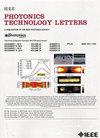基于视网膜启发红外探测器阵列的传感器内卷积计算
IF 2.3
3区 工程技术
Q2 ENGINEERING, ELECTRICAL & ELECTRONIC
引用次数: 0
摘要
在红外探测领域,随着探测波长和空间成像分辨率的提高,分离传感和处理的传统架构难以满足机器视觉指数级增长的需求。受人类视觉系统对视网膜进行预处理以减轻信息传输负担的启发,我们提出了一种MSM(金属/半导体- ingaas /金属)结构的视网膜启发红外探测器。该检测器允许通过调整偏置电压来调制响应极性和振幅,从而在检测器内部实现一系列预处理操作。Au/InGaAs/Au类视黄醛探测器在短波红外区域表现出可调谐的正、负光响应,响应速度高达490 ns,有利于超快速的图像信息预处理。我们提出了一个$16\ × 16$的传感器内计算硬件系统,能够直接在检测器内部部署各种卷积核来执行卷积操作,为轻量级卷积神经网络硬件提供了独特的机会。本文章由计算机程序翻译,如有差异,请以英文原文为准。
In-Sensor Convolutional Computation Based on Retina-Inspired Infrared Photodetector Array
In the field of infrared detection, as the resolution of detection wavelengths and spatial imaging improves, traditional architectures that separate sensing and processing struggle to meet the exponentially growing demands of machine vision. Inspired by the human visual system, which performs preprocessing on the retina to reduce the burden of information transmission, we propose an MSM (metal/semiconductor-InGaAs/metal) structure retina-inspired infrared photodetector. This detector allows the modulation of response polarity and amplitude by adjusting the bias voltage, enabling a range of preprocessing operations inside the detector. The Au/InGaAs/Au retinal-like detector exhibits tunable positive and negative photoresponses in the short-wave infrared region, with a response speed of up to 490 ns, facilitating ultra-fast image information preprocessing. We propose a $16\times 16$ in-sensor computing hardware system capable of deploying various convolution kernels directly inside the detector to perform convolution operations, offering a unique opportunity for lightweight convolutional neural network hardware.
求助全文
通过发布文献求助,成功后即可免费获取论文全文。
去求助
来源期刊

IEEE Photonics Technology Letters
工程技术-工程:电子与电气
CiteScore
5.00
自引率
3.80%
发文量
404
审稿时长
2.0 months
期刊介绍:
IEEE Photonics Technology Letters addresses all aspects of the IEEE Photonics Society Constitutional Field of Interest with emphasis on photonic/lightwave components and applications, laser physics and systems and laser/electro-optics technology. Examples of subject areas for the above areas of concentration are integrated optic and optoelectronic devices, high-power laser arrays (e.g. diode, CO2), free electron lasers, solid, state lasers, laser materials'' interactions and femtosecond laser techniques. The letters journal publishes engineering, applied physics and physics oriented papers. Emphasis is on rapid publication of timely manuscripts. A goal is to provide a focal point of quality engineering-oriented papers in the electro-optics field not found in other rapid-publication journals.
 求助内容:
求助内容: 应助结果提醒方式:
应助结果提醒方式:


